Our story
Now owned by the family behind the Crazy Acres brand in Darwin, Lush Ice Pops are the perfect compliment to their homemade ice cream and their other frozen ice pops. The previous owner of Lush Ice Pops travelled around Australia and saw other artisan ice pop makers gracing the streets of the capital cities and brought the idea back to Darwin.
With 2 teenagers in the Lush/Crazy Acres family who live with dietary requirements, it is important for us to make an ice pop for everyone to enjoy.
While all of our current pops are Gluten free, we have a range that are also Dairy Free, and Vegan friendly. We have a Fructose Free pop, our Mango and Mango & Coconut Pops are completely Sugar Free.
Crazy Acres has been operating since 2008 on the family Mango Farm in Berry Springs, 60kms south of Darwin and started making homemade ice cream a few years later.
To read our story from the beginning, head over to www.crazyacres.com.au
Buying Lush Ice Pops at the end of 2022, a few flavours were rolled out in 2023 through the Crazy Acres Kiosk at Berry Springs Nature Park and the Deckchair Cinema in Darwin to “test the waters”.
New packaging was designed and printed in January 2024 ready for the season to begin. Ideas for many more flavours are in the pipeline and we can custom make flavours for bespoke events or to compliment your business.
Stocking Lush Ice Pops alongside the insanely delicious Crazy Acres homemade ice cream, you will be able to find our products around the Top End.
Dry season is the perfect time for a refreshing swim and not many places beat Berry Springs Nature Park. Find our full range of Lush Ice Pops and Crazy Acres ice cream at the Crazy Acres Kiosk within the park. Open 7 days a week while the pools are open for swimming. Opening times can be found at Things To Do | Berry Springs Nature Park And Kiosk | Swimming Area (crazyacres.com.au)
Check back regularly as we update the page to reflect our stockists, new flavours, events and more.
Some 'poppy' fun facts
History
Frank Epperson of Oakland, California, popularised ice pops after patenting the concept of "frozen ice on a stick" in 1923. He initially called it the Epsicle. A couple of years later, Epperson sold the rights to the invention and the Popsicle brand to the Joe Lowe Company in New York City.
Epperson claimed to have first created an ice pop in 1905 at the age of 11 when he accidentally left a glass of powdered soda and water with a mixing stick in it on his porch during a cold night, a story still printed on the back of Popsicle treat boxes.
Terminology
In the United States and Canada frozen ice on a stick is generically referred to as a popsicle due to the early popularity of the Popsicle brand, and the word has become a genericized trademark to mean any ice pop or freezer pop, regardless of brand or format. (The word is a portmanteau of pop and icicle.) They are also called an ice pop or freezer pop in the United States. In the Caicos Islands it is referred to as an ice saver. In the United Kingdom and Ireland the terms ice lolly and ice pop are used, though ice pop is much more common in Ireland. Chihiro is used as a slang term in the Cayman Islands, partially derived from chill. Different parts of Australia use either ice block or icy pole, and New Zealand uses ice block.
Paletas – the inspiration for Lush Ice Pops
A paleta is a frozen treat from Mexico. The word paleta is derived from palo – meaning stick. Essentially they are ice pops, delicious flavoured liquids, frozen with a stick to hold as you eat them. They are made from an enormous variety of fruits and other ingredients including spices and herbs and even flowers. They often include chunks of fruit inside. There are two different types of paleta - Paletas de agua (water/fruit based) and Paletas de crema which are made with some kind of dairy.
Paletas are found everywhere in Mexico and are sold from a paletaria (shop front) or from a mobile vendor with a cart.
Most paletarias are family businesses and the frozen treats are made in an artisanal way. The produce is purchased from markets then peeled, chopped and pureed by hand.







